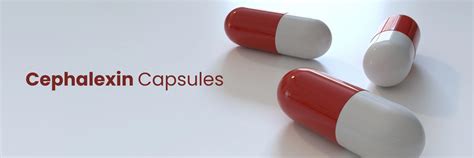Intro
Discover key facts about Cephalexin, a broad-spectrum antibiotic, including its uses, side effects, and interactions, to understand its role in treating bacterial infections, such as strep throat and skin infections, with effective dosage and precautions.
Cephalexin is a type of antibiotic that belongs to the group of cephalosporins. It is widely used to treat various bacterial infections, including those affecting the skin, respiratory tract, and urinary tract. The importance of understanding cephalexin lies in its effectiveness and potential side effects, which can vary from person to person. As we delve into the world of cephalexin, it's crucial to separate fact from fiction and explore the benefits and risks associated with this medication. Whether you're a healthcare professional or simply someone interested in learning more about antibiotics, this article aims to provide a comprehensive overview of cephalexin, covering its uses, mechanisms, and essential facts.
The rise of antibiotic resistance has made it more critical than ever to use antibiotics like cephalexin responsibly. By understanding how cephalexin works and its potential side effects, individuals can make informed decisions about their health. Moreover, the role of cephalexin in treating common infections highlights its significance in modern medicine. As we explore the realm of cephalexin, we'll uncover the intricacies of its mechanism, its applications, and the precautions one should take when using this antibiotic.
The application of cephalexin is diverse, ranging from treating mild infections to more severe conditions. Its effectiveness against a broad spectrum of bacteria has made it a staple in many healthcare settings. However, like all medications, cephalexin is not without its risks and side effects. From allergic reactions to interactions with other medications, there's a lot to consider when prescribed cephalexin. This article aims to guide readers through the complex world of cephalexin, providing insights into its benefits, risks, and the essential facts everyone should know.
Introduction to Cephalexin

How Cephalexin Works
The working mechanism of cephalexin involves binding to penicillin-binding proteins (PBPs) located inside the bacterial cell wall. By doing so, it inhibits the cross-linking of peptidoglycan chains, which are essential components of the bacterial cell wall. Without a functional cell wall, the bacterial cell cannot survive, especially in environments with high osmotic pressure, leading to cell lysis and death. This action is specific to bacteria and does not affect human cells, making cephalexin a safe and effective antibiotic for treating bacterial infections.Benefits of Cephalexin

Common Uses of Cephalexin
Cephalexin is commonly used to treat: - Respiratory tract infections such as pneumonia and bronchitis - Skin and soft tissue infections like cellulitis and abscesses - Urinary tract infections, including cystitis and pyelonephritis - Bone and joint infections - Dental infectionsIts effectiveness against these conditions has made cephalexin a first-line treatment option for many physicians. However, the choice of antibiotic should always be guided by culture and sensitivity results when possible, to ensure the most effective treatment and minimize the development of antibiotic resistance.
Side Effects and Precautions

Contraindications and Warnings
Cephalexin is contraindicated in patients with known hypersensitivity to cephalosporins. It should be used with caution in patients with renal impairment, as it is primarily excreted by the kidneys, and dose adjustments may be necessary. Pregnant or breastfeeding women should only use cephalexin under the guidance of a healthcare provider, as there is limited data on its safety during these periods.Resistance and Misuse

Strategies to Combat Resistance
To combat antibiotic resistance, strategies include: - Using antibiotics only when necessary and under the guidance of a healthcare provider - Completing the full course of antibiotic treatment as prescribed - Avoiding the use of antibiotics for viral infections - Promoting good hygiene practices to prevent the spread of infections - Supporting research and development of new antibiotics and alternative treatmentsConclusion and Future Perspectives

Final Thoughts
The importance of cephalexin in modern medicine cannot be overstated. By understanding its benefits, risks, and the critical issue of antibiotic resistance, we can work towards ensuring that this valuable resource remains effective for generations to come. Whether you're a patient, a healthcare provider, or simply someone interested in health and wellness, the story of cephalexin serves as a reminder of the power and responsibility that comes with antibiotic use.What is cephalexin used for?
+Cephalexin is used to treat various bacterial infections, including skin, respiratory, and urinary tract infections.
How does cephalexin work?
+Cephalexin works by inhibiting the synthesis of the bacterial cell wall, leading to the death of the bacterial cell.
What are the common side effects of cephalexin?
+Common side effects include gastrointestinal disturbances like diarrhea and nausea, and in rare cases, hypersensitivity reactions.
Can cephalexin be used in patients with penicillin allergy?
+Cephalexin should be used with caution in patients with a history of penicillin allergy due to the risk of cross-reactivity.
How can antibiotic resistance be prevented?
+Antibiotic resistance can be prevented by using antibiotics only when necessary, completing the full course of treatment, and avoiding the use of antibiotics for viral infections.
We hope this comprehensive guide to cephalexin has been informative and helpful. Whether you have questions about its use, side effects, or the broader issue of antibiotic resistance, we encourage you to share your thoughts and engage in the conversation about responsible antibiotic use. Your feedback and insights are invaluable in our collective effort to promote health and wellness.
